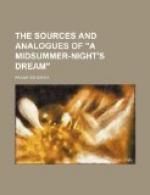“That Orfeo hight, as
men well wote; Good is the lay, sweet is the
note!”
The ballad which represents the debris of this romance has only been recovered in a single text, from the memory of an old man in Unst, Shetland, and it is incomplete in verse-form, though the reciter remembered the gist of the story. This version of the ballad is further complicated by the fact that the old man sang it to a refrain which appears to be Unst pronunciation of Danish—a startling instance of phonetic tradition.
It is not, however, to be understood from this that it was impossible for Shakespeare to have heard this ballad; English versions may have been current in his time. But even so, the ballad would add nothing to the knowledge he might gain elsewhere; it is simply a short form of the romance altered by tradition.[67]
There are half-a-dozen other English and Scottish ballads concerning fairies, none of much importance touching our present theme. They may be best studied in Child’s collection, Nos. 35-41, where under Tam Lin he has put together the main features of fairy-lore revealed in traditional ballads.[68] One or two such points may be noted here.
We have seen that Ogier saw the supernatural lady after plucking and eating an apple from a tree. Thomas of Erceldoune, Launfal, and Meroudys, are sleeping or lying beneath a tree when they see their various visitors. Tam Lin in the ballad was taken by the fairies while sleeping under an apple tree. Malory[69] tells us that Lancelot went to sleep about noon (traditionally the dangerous hour) beneath an apple tree, and was bewitched by Morgan le Fay. In modern Greek folk-lore, certain trees are said to be dangerous to lie under at noon, as the sleeper may be taken by the nereids, who correspond to our fairies.
At certain intervals—every seven years, the ballads say—the fiend of hell takes a tithe from the fairies, usually preferring one who is fair and of good flesh and blood. Hence in Thomas of Erceldoune,[70] the elf queen is anxious that he should leave her realm, because she thinks the foul fiend would choose him (ll. 219-224).
The notion of the fairies’ demand of a tithe of produce, agricultural or domestic, is parallel to this sacrifice.[71]
A third point on which fairy-lore usually insists is that the steeds of the fairies shall be white; here Thomas of Erceldoune is at variance with the other poems, the elf-queen’s palfrey being a dapple-grey. It is curious to learn that this superstition still survives. “At that time there was a gentleman who had been taken by the fairies, and made an officer among them, and it was often people would see him and her riding on a white horse at dawn and in the evening."[72]




